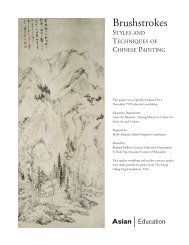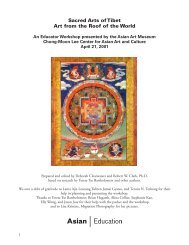Download PDF - Asian Art Museum | Education
Download PDF - Asian Art Museum | Education
Download PDF - Asian Art Museum | Education
You also want an ePaper? Increase the reach of your titles
YUMPU automatically turns print PDFs into web optimized ePapers that Google loves.
Muromachi Period Tea [1338–1573]<br />
During the Muromachi period the vogue for Chinese art, especially among the Ashikaga<br />
shoguns (the Ashikaga family ruled as the military leaders of Japan in this period), led to the<br />
development of new architectural environments in which to display such collections. <strong>Art</strong>,<br />
architecture, tea, and temple etiquette melded, to produce a secular style of tea known as<br />
shoin, after the rooms in which it was served that were modeled on a Chinese scholar’s<br />
study. The Ashikaga collection became so vast that a staff of curators was necessary to maintain<br />
it. They were responsible for the care of the objects, the creation of a setting that<br />
allowed the beauty of the objects to show forth, and for the preparation and presentation of<br />
tea. At early shoin gatherings, the host did not make tea himself, but sat with the guests and<br />
was served tea by the curators. Reflecting the wealth and power of the early Ashikaga<br />
shoguns, shoin-style tea emphasized collection, evaluation, and display of Chinese art in its<br />
characteristic perfection of form, superlative technique, and flawless surface beauty.<br />
The rule of the eighth Muromachi shogun, Ashikaga Yoshimasa (1436–1490) corresponds<br />
with the beginning of the century of civil strife known as the Sengoku “Country at War” era<br />
(1467–1568). Under these turbulent circumstances, Yoshimasa retired to a villa popularly<br />
known as Ginkakuji, Temple of the Silver Pavilion, located in the eastern hills of Kyoto.<br />
Through Yoshimasa’s patronage of the arts of poetry, calligraphy, painting, No drama and<br />
shoin-style tea, his villa became the locus of an aesthetic known as Higashiyama Bunka (eastern<br />
hills culture). Higashiyama culture, while still based on Chinese objects, tended toward<br />
the spare and understated, reflecting the aesthetic concept of yugen, a subtle, mysterious elegance.<br />
Despite this subtle shift in emphasis, Yoshimasa’s tea remained within the elevated<br />
shoin tradition that subsequently served as the classic model from which other forms of tea<br />
would emerge.<br />
Toward the end of the Muromachi period aesthetic trends led away from the formal, Chinese<br />
influenced shoin-style tea. This change is personified in the figure of townsman tea<br />
master Murata Shuko (1423–1502) who conceived of tea as a form of aesthetic discipline<br />
based on the literary ideals of hie karu (chill and withered), some say through the influence<br />
of the Daitokuji Zen abott Ikkyu Sojun. Shuko’s tea is best expressed in the aphorism, “The<br />
moon not glimpsed through rifts in clouds holds no interest.” Shuko championed the pairing<br />
of rustic Japanese ceramics from Bizen and Shigaraki with reticent Chinese tea bowls<br />
and tea containers whose imperfections would have barred them from the Ashikaga collection.<br />
Sakui (skillful inventiveness) and toriawase (interesting combinations of utensils)<br />
became the focus of townsman gatherings, as the role of host came to include the act of personally<br />
preparing tea in front of the guests. At the same time, there developed to be a growing<br />
preference for small retreat-like environments, constructed in the style of native<br />
farmhouses, in which to hold tea gatherings. The deliberate meagerness of the structure was<br />
intended to convey it as a shelter conducive to an investigation into truth by minds that<br />
cared nothing for worldly matters. The word soan (grass hut) is used to describe this new<br />
urban pastoral aesthetic.<br />
The transition from shoin to soan aesthetics continued to develop and mature in the hands<br />
of increasingly powerful merchant townsmen from Kyoto, Nara, and Sakai. They eagerly<br />
sought out pieces dispersed from the collection of the now virtually powerless Ashikaga, but<br />
used the objects in contexts much removed from shoin forms. The merchants saw tea as a<br />
medium to give voice to their own social, philosophical, and aesthetic concerns. In this<br />
tumultuous era the spirit of communion fostered by the atmosphere of the tearoom<br />
<strong>Asian</strong> <strong>Art</strong> <strong>Museum</strong> <strong>Education</strong> Department
















